Psilocybin Mushrooms: Biology, Chemistry, and Therapeutic Promise
What Are Psilocybin Mushrooms?
Psilocybin mushrooms – often called “magic mushrooms” or “shrooms” – are a group of fungi that produce the naturally occurring psychedelic compound psilocybin. These mushrooms are found across the world, from tropical forests to grassy meadows. Psilocybin-containing mushrooms are typically gilled and dark-spored, growing on rich soils, forest debris, or even animal dung. For example,Psilocybe cubensis– one of the most widely known species – thrives in warm, subtropical pastures and often fruit on cow or buffalo dung. Overall, there are over 200 known psilocybin-bearing mushroom species (mostly in the genus Psilocybe), though most are relatively uncommon outside their native habitats. The most potent psilocybin-producing mushrooms are typically species within the genus Psilocybe, such as Psilocybe azurescens, Psilocybe semilanceata, and Psilocybe cyanescens. However, the compound psilocybin has also been identified in roughly a dozen other fungal genera, including Panaeolus (also known as Copelandia), Inocybe, Pluteus, Gymnopilus, and Pholiotina.
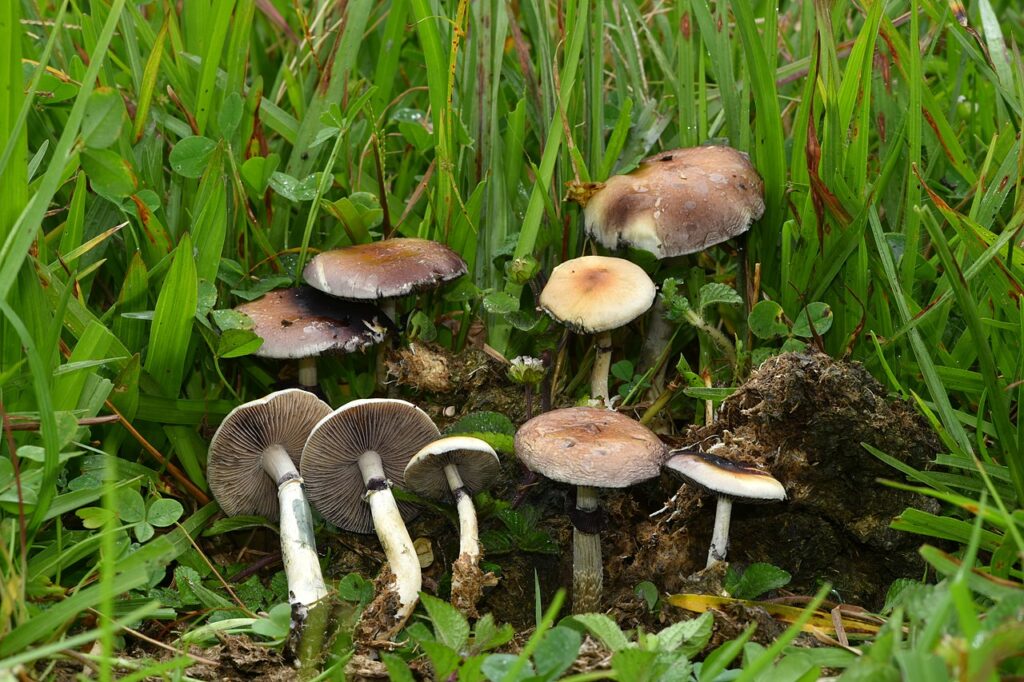
Where Psilocybin Mushrooms Grow in Nature
In a deep 2000 review of the global distribution of psilocybin mushrooms, mycologist Gastón Guzmán and colleagues identified species containing psilocybin across several fungal genera. The breakdown included: Psilocybe (116 species), Gymnopilus (14 species), Panaeolus (13), Copelandia (12), Pluteus (6), Inocybe (6), Pholiotina (4), and Galerina (1). By 2005, Guzmán revised his estimate for the Psilocybe genus, noting an increase to 144 known psilocybin-containing species.

Geographically, a significant number of these mushrooms are native to Mexico, where 53 species have been documented. Additional distributions include Canada and the United States (22 species), Europe (16), Asia (15), Africa (4), and Australia and its surrounding islands (19). Most psilocybin mushrooms are dark-spored, gilled fungi that thrive in humid, subtropical or tropical environments, particularly in meadows, woodlands, and soil enriched with humus and decaying plant material. Though these mushrooms can be found on every continent, they are especially concentrated in humid subtropical forests.

Among the most recognized species, Psilocybe cubensis is the most prevalent in tropical regions, commonly growing on animal dung in warm climates. In contrast, Psilocybe semilanceata—known as the Liberty Cap—is considered the most widely distributed psilocybin mushroom globally. It is found in temperate zones across Europe, North and South America, Asia, Australia, and New Zealand, though it notably does not occur in Mexico. In a notable update from 2024, two new species belonging to the Psilocybe genus (Hymenogastraceae)—Psilocybe ingeli and Psilocybe maluti—were officially identified in southern Africa.
Interestingly, some bolete mushrooms, which are not closely related to known psilocybin-producing species, have also been reported to cause hallucinogenic effects. This has been observed in regions such as China’s Yunnan province. Although the precise identity of these bolete species and their psychoactive compounds remains unclear, legendary chemist Albert Hofmann once detected unidentified indole compounds in species like Boletus manicus, hinting at the possibility of unknown hallucinogens in unrelated fungi groups.
Psilocybin Mushrooms Chemistry and Brain Effects
Psilocybin itself is the key active chemical in these mushrooms. Chemically, psilocybin is a tryptamine alkaloid (4-phosphoryloxy-N,N-dimethyltryptamine). When a person ingests psilocybin – usually by eating the dried mushroom or brewing it as tea – the body quickly converts it into another compound called psilocin. This happens via dephosphorylation (removing a phosphate group) by natural enzymes in the gut and liver. Psilocin is structurally similar to the neurotransmitter serotonin; in fact, it binds to serotonin receptors in the brain. In particular, psilocin is a potent agonist of the 5-HT2A serotonin receptor, and also affects other serotonin receptor subtypes. This 5-HT2A activation is widely considered the main trigger of the psychedelic or “tripping” experience. Notably, researchers report that psilocybin and psilocin have relatively low toxicity and low abuse potential compared to many drugs.
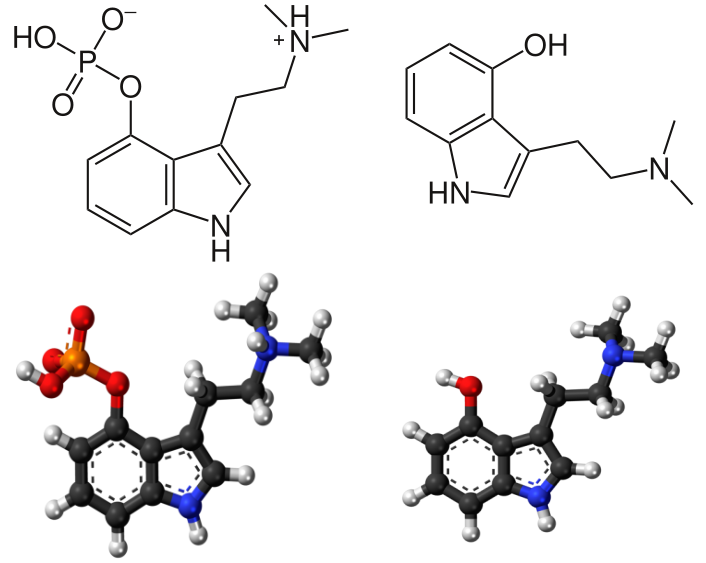
The Chemical Composition of Magic Mushrooms
The chemical makeup of magic mushrooms varies significantly between genera and even among species. The primary psychoactive compound found in these fungi is psilocybin, which the human body converts into psilocin, the active molecule responsible for the psychedelic effects. In addition to psilocin, magic mushrooms may also contain related compounds such as norpsilocin, baeocystin, norbaeocystin, and aeruginascin. These secondary alkaloids are believed to contribute to an entourage effect—a synergistic interaction that can influence the overall experience and modify the intensity or nature of the psychoactive effects.
Animal studies support the idea that consuming whole psilocybin mushrooms may produce different effects than isolated psilocybin or psilocin alone. This suggests that the combination of various active compounds within the mushrooms could interact to create a more complex and unique psychedelic experience.
Some magic mushrooms also produce β-carboline alkaloids, including harmine, harmane, tetrahydroharmine (THH), and harmaline. These compounds are known to inhibit monoamine oxidase (MAO), an enzyme that breaks down tryptamine-based substances like psilocin. The presence of MAO inhibitors can prolong and intensify the effects of psilocybin. β-carbolines have been identified in several mushroom genera, including Psilocybe, Cyclocybe, and Hygrophorus. Specifically, Psilocybe species have been found to contain harmine, harmane, norharmane, and other related β-carbolines.
The presence of β-carbolines in psilocybin mushrooms may enhance the bioavailability and potency of psilocybin by slowing its breakdown in the body. This biochemical interaction adds another layer of complexity to the overall effects of magic mushrooms, highlighting the importance of considering the full spectrum of active compounds when studying or using these fungi.
How Psilocin Works
The activation of serotonin receptors by psilocin causes widespread changes in brain activity. Neuroimaging studies show that psilocybin leads to a temporary disruption of the brain’s default mode network (DMN) – a set of regions normally involved in self-reflection and mind-wandering. Under psilocybin, the DMN becomes desynchronized and less connected, while other parts of the brain communicate more globally. Brain regions that normally “talk” tightly to each other during waking life loosen up, creating new patterns of connectivity. These network changes correlate with reported subjective effects: many users feel their sense of self dissolve (“ego-dissolution”), and experience a sense of unity or oneness with their environment. Disrupting the DMN reduces self-focus and can lead to “a greater feeling of openness and increased connectedness to the world.”
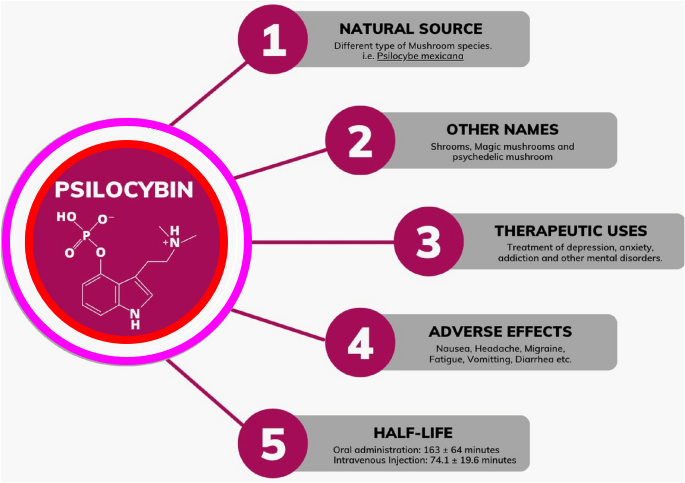
Subjectively, a psilocybin experience often includes vivid changes in perception, thought, and emotion. Users frequently report visual effects (colors more intense, geometric patterns in the mind’s eye) and synesthesia (mixing senses, like “seeing sounds”). A person may feel time slow down or become unmoored. Many describe profound emotional effects: feelings of bliss, awe, and connectedness are common, and experiences described as mystical or spiritual often occur. However, experiences can also be challenging – bad trips involving fear or anxiety have been documented. The quality of a trip depends strongly on “set and setting” (mindset and environment). In all cases, the drug’s effects peak in 2–3 hours and generally fade by 6–8 hours after ingestion.
Psilocybin’s Brain Effects
Pharmacologically, psilocybin’s brain effects mirror those of other classic psychedelics (like LSD), but with some nuances. Psilocybin’s action on 5-HT2A receptors leads to downstream changes: it increases neural plasticity, shifts thalamic filtering of sensory information, and alters the release of other neurotransmitters. For example, some studies suggest psilocybin increases glutamate in the prefrontal cortex, potentially enabling new neural connections. These changes can transiently heighten emotion and cognition, and even produce lasting psychological insights. Researchers believe this neuroplastic window helps integrate experiences into long-term change. In short, psilocybin’s chemistry – being a serotonin-like prodrug converted into an active agonist – underlies its profound acute effects on brain function and consciousness.
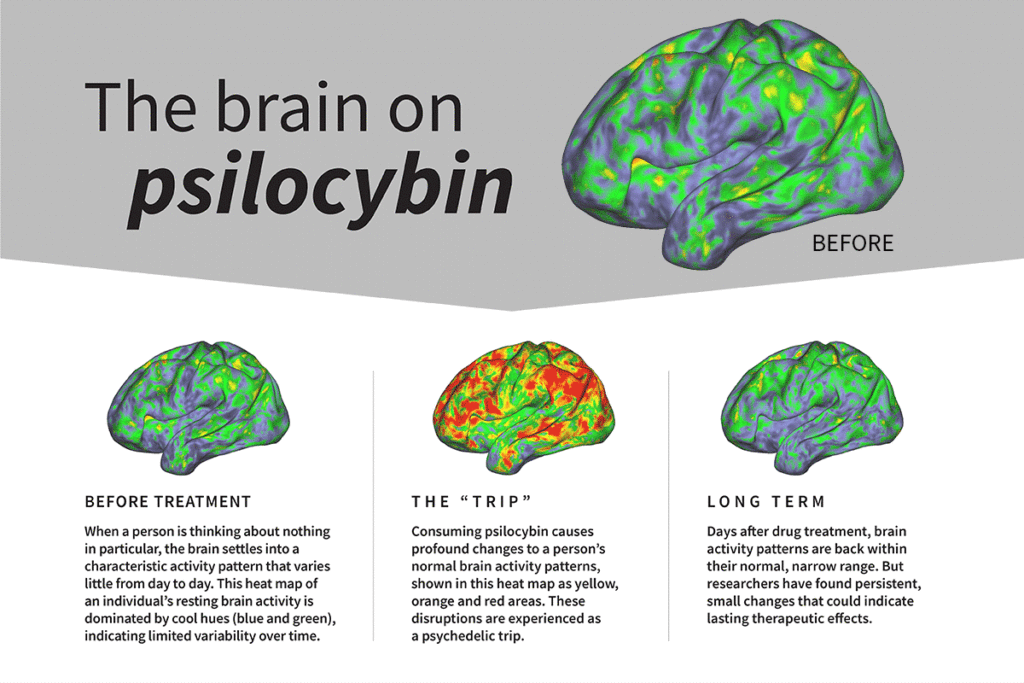
Therapeutic Potential of Psilocybin Mushrooms
In recent years, interest in psilocybin for medicine has exploded. Clinical studies suggest that, under professional supervision, psilocybin-assisted therapy can yield large and lasting improvements in several mental health conditions. Prominent trials have shown especially strong effects in treatment-resistant depression. A 2023 meta-analysis found that psilocybin therapy produced a significantly larger reduction in depression scores than placebo, with effect sizes far exceeding conventional antidepressants. Psilocybin has shown efficacy for treating depression, anxiety, and substance use in clinical studies. In practical terms, many patients in trials with major depression have reported dramatic mood lifts weeks or months after just one or two psychedelic sessions, often when they had failed to respond to other treatments.
Anxiety and Depression
Psilocybin-assisted therapy also shows promise for anxiety, especially in end-of-life or cancer-related distress. Several trials have treated patients with life-threatening illnesses (like metastatic cancer) using a single high dose of psilocybin plus psychotherapy. These have found rapid and sustained reductions in anxiety and existential fear. One landmark study found that terminal cancer patients given psilocybin experienced profound mystical-type experiences that led to decreased anxiety and improved quality of life for many months. Similarly, in smaller studies of obsessive-compulsive disorder (OCD), a single dose of psilocybin has sometimes eased symptoms, hinting at benefits for anxiety-spectrum conditions.
Substitution Therapy
Another important area is addiction. Encouraging evidence suggests psilocybin therapy can help people quit smoking or reduce heavy drinking. One systematic review of psilocybin trials in substance use disorders reported that all four clinical trials (targeting alcohol or tobacco use) showed beneficial effects. In a pioneering study of nicotine addiction, 80% of participants were still smoke-free at 6 months after psilocybin sessions – far above typical quit rates. Alcohol-dependence trials have likewise observed significant reductions in heavy drinking days after therapy. These outcomes may be due to psilocybin fostering new perspectives and motivations: many subjects describe the sessions as “life-changing,” leading them to reevaluate their habits.
PTSD Treatment
Research on post-traumatic stress disorder (PTSD) is still in early stages, but it is rapidly expanding. To date, few formal trials of psilocybin for PTSD have been completed. However, experts note that psilocybin’s effects (enhanced emotional processing, fear extinction, and feelings of connectedness) could theoretically address core PTSD mechanisms. Psychedelic-assisted therapy for PTSD is of growing interest, especially since similar protocols (like MDMA-assisted therapy) have shown positive results. Anecdotal reports and some small studies (e.g., in trauma survivors) also hint that psychedelic therapy can alleviate trauma symptoms when combined with therapy. More research is underway to test psilocybin specifically for PTSD patients.
Summary
In these clinical settings, psilocybin is never given casually. The studies all use psychedelic-assisted therapy (P-AT): patients meet with trained therapists for preparation, dosing, and integration sessions. Participants take only one or two moderate-to-high doses (often 20–30 mg of pure psilocybin) in a controlled setting, with eyeshades and music, and a therapist present. This combination of drug and professional support appears crucial: researchers believe the drug opens a window, but the therapy guides its healing effects. A recent meta-analysis found that, across trials, psilocybin-assisted therapy produced large, statistically significant improvements in anxiety and depression. Many patients report not only symptom relief but enduring positive changes in outlook, mood stability, and even personality traits like openness.
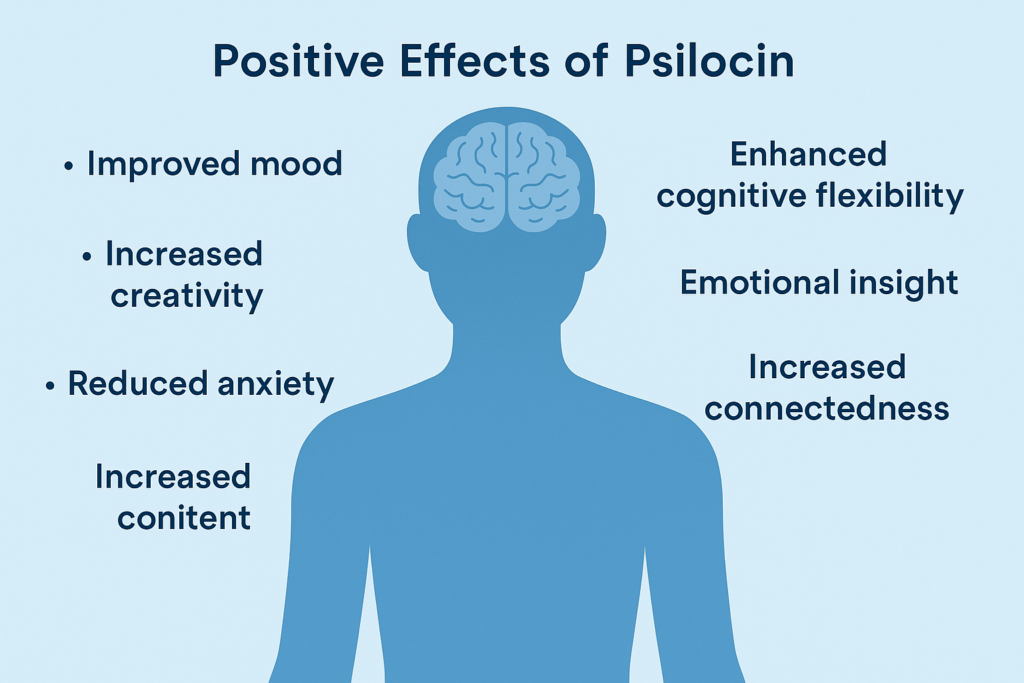
The mechanisms for these benefits are under investigation. Psilocybin may “reset” rigid brain network activity patterns seen in depression, allowing new connections and thought patterns to form. It may enhance psychological flexibility, help extinguish learned fear responses, and strengthen social-emotional circuitry in the brain. The profound subjective experiences (even mystical ones) often lead patients to new perspectives on their problems. Preliminary evidence also suggests psilocybin can increase neurogenesis and synaptic plasticity, offering a biological basis for sustained improvement. In short, psilocybin’s brain-level effects, combined with guided therapy, appear to yield rapid and durable therapeutic outcomes in several difficult-to-treat conditions.
Legal and Scientific Developments of Psilocybin Mushrooms
As clinical evidence accumulates, the legal status of psilocybin is shifting. For decades, psilocybin was classified as an illicit Schedule I drug in the US and many countries, meaning “high potential for abuse and no accepted medical use.” However, in recent years some jurisdictions have begun to liberalize psilocybin laws. Notably, Oregon became the first U.S. state in 2020 to legalize psilocybin therapy under supervised conditions. Colorado followed in 2022, and California legislators are actively debating similar bills. Internationally, Australia has approved limited medical prescriptions of synthetic psilocybin for treatment-resistant depression, and Canada allows psilocybin therapy for palliative and emergency psychiatric use under medical supervision. Even some cities like Denver, Colorado, and Oakland, California have decriminalized personal possession of psilocybin. As of early 2025, several places including Australia, Oregon, Colorado, and Alberta in Canada have explicitly legalized psilocybin for medicinal, supervised use.
In April 2025, New Mexico’s governor signed a “Medical Psilocybin Act,” establishing a regulated program for psilocybin therapy for conditions like treatment-resistant depression, PTSD, and substance abuse. In that law, qualified patients will receive psilocybin treatment via a structured process (preparation, dosing, and integration) under licensed providers.
The scientific and regulatory community is taking notice. The U.S. Food and Drug Administration (FDA) has granted “Breakthrough Therapy” status to several psilocybin-based therapies, expediting their clinical trials for depression and other conditions. In 2023, the FDA released draft guidance specifically for psychedelic drug trials, advising industry on designing studies for compounds like psilocybin. Major research centers such as Johns Hopkins, Imperial College London, and UCLA are rapidly expanding psychedelic programs. Biotech companies are developing pure psilocybin pills and novel analogs. One firm recently earned FDA breakthrough status for a synthetic psilocybin analog aimed at depression. This reflects a “psychedelic renaissance”: after decades of prohibition, psilocybin is now the subject of hundreds of clinical trials worldwide.
Despite these advances, psilocybin remains illegal at the federal level in many countries, and unsupervised use can have risks. However, health authorities recognize its low toxicity: deaths from psilocybin alone are virtually unheard of, and modern studies emphasize safety when the drug is administered properly. The coming years will likely see continued debate, but overall the trend is toward carefully controlled medical adoption of psilocybin therapy. Advocates and scientists stress that more large-scale trials are needed, but they are optimistic that psilocybin could become a valuable tool for treating some of the toughest mental health problems.
Conclusion
In summary, psilocybin mushrooms are not just folklore “magic”; they are biologically fascinating fungi that produce a powerful compound with real medical promise. Their biology ties them to rich soils and old-world traditions, but their chemistry connects them to cutting-edge neuroscience. As research reveals how psilocybin rewires the brain in healing ways, the legal landscape is evolving to reflect its potential. The story of psilocybin mushrooms is a prime example of how ancient natural compounds are being re-appreciated in modern science and medicine.
Sources
- Shah, Fatima Iftikhar, et al. “Unveiling the psychedelic journey: an appraisal of psilocybin as a profound antidepressant therapy.” Molecular Biotechnology 67.1 (2025): 36-53. https://link.springer.com/article/10.1007/s12033-023-00994-7
- Stamets, Paul. Psilocybin mushrooms of the world: an identification guide. Ten Speed Press, 2023. https://www.tandfonline.com/doi/abs/10.3109/15563659809162584
- https://en.wikipedia.org/wiki/Psilocybin_mushroom
- https://medicine.washu.edu/news/mushrooms-generate-psychedelic-experience-by-disrupting-brain-network/


